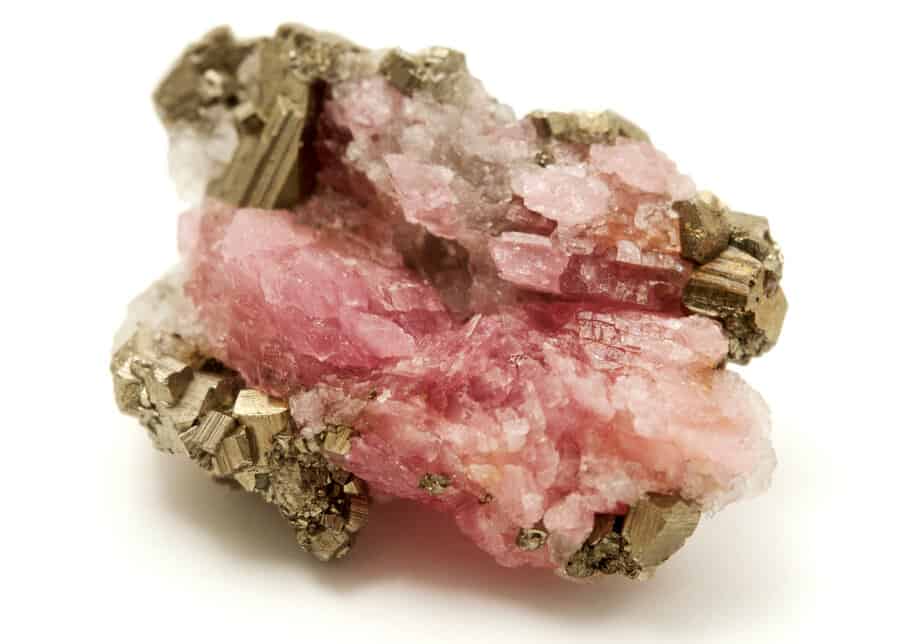Colorado is one of the best states in the U.S. for rockhounds, largely due to its incredible mountain ranges and complex geology. It also holds a special place in my heart as I grew up spending summers in Crested Butte. The state has thousands upon thousands of old mines and prospective rockhounding locations. Almost anywhere you turn in Colorado there will be something worth finding because collectible rocks and minerals are well distributed throughout the entire state.
Of course, with the mountainous terrain comes the complications of weather and accessibility. The best time to rockhound in Colorado will be between Spring and Fall when the weather is warm enough and the ground isn’t covered in snow. Many promising locations are difficult to access without a capable vehicle. The eastern part of the state is generally more accessible and, despite its lack of mountains, produces many rock and mineral specimens as float transported by rivers and streams.
The best places to rockhound in Colorado include the areas around Denver, Colorado Springs, Fort Collins, and Gunnison, as well as Chaffee, Mesa, and Mineral Counties. A wide variety of rocks and minerals can be found including rhodonite, amethyst, sphalerite, agate, garnet, fluorite, and fossils.
| State Symbols | |
|---|---|
| State Mineral | Rhodochrosite |
| State Rock | Yule Marble |
| State Gemstone | Aquamarine |
| State Fossil | Stegosaurus |

If you’ve already found a rock and you’re not sure what it is, I would highly recommend checking out my Practical Rock Identification System. This bundle of information includes a book, videos, and online tools. It is, simply put, the most comprehensive and easy-to-understand rock identification system you’ll find anywhere.
You can also read through my free rock identification guide and mineral identification guide which are filled with useful information and tools.
Through quite a bit of research and cross-referencing of available literature, I have compiled this list of some prospective locations in Colorado which I would recommend to people looking to do some rockhounding. These are mostly comprised of old mining prospects, streams, and historically known rock and mineral collecting sites. For additional reading, I’d highly recommend these books you can find on Amazon:
Please remember that rock collecting locations are constantly changing. Specimens may become depleted from other collectors, the location may have been built on or altered, locality information in literature may be inaccurate, and property ownership may have changed hands. Though there are many locations listed here, this list is far from exhaustive. A location’s listing here is not a guarantee of accuracy. Be safe, never go underground, and make sure to get permission from the landowner to search for and collect specimens.
If you’re planning on heading to the field, make sure you have all the gear you’ll need! To get started, you can check out my recommended gear page which contains my full reviews for every Geologist’s favorite rock hammer and the best hiking backpack I’ve ever owned.
Colorado Rockhounding Locations
Important Disclaimer: I have not been to these locations myself, and I do not know if they are currently open for collecting. Use this resource as a guide to get you started. Follow posted signage and always get permission from the landowner to collect.
NOTE: All the locations listed in these tables are clickable, and will take you to the location on Google Maps.
Chaffee County
Chaffee County is home to many old mining prospects, making it a prime destination for rockhounds. Old mines and the surrounding hills and stream beds contain a countless variety of rocks and minerals including sapphire, garnets, topaz, fluorite, quartz crystals, epidote, and tourmaline. As always, take care never to go underground when searching.
| Location | Rocks & Minerals |
|---|---|
| Sugarloaf & Ruby Mts | Rhyolite, Perlite, Apache tears (‘black rubies’), Spessartine, Topaz (yellow), Feldspar, Quartz crystals |
| Summit of Mt. Antero (7 mile hike) | Apatite, Aquamarine, Beryl, Bismutite, Calcite, Fluorite (white, green, purple), Pyrite, Smoky Quartz crystals, etc. |
| Chalk Creek gravels, area | Sapphire |
| Sedalia Copper Mine (Turret Creek area) | Actinolite, Almandine, Azurite, Beryle, Chrysocolla, Epidote, Kyanite, Pyrite, Quartz crystals, Tourmaline, etc. |
| Calumet Iron Mine | Amphibole, Chalcopyrite, Corundum, Epidote, Pyrite, Muscovite, Quartz crystals, Sagenitic Quartz, Sapphire, etc. |
Denver
The area around Denver, particularly west into Jefferson County, is a fantastic destination for rockhounds. The best places to search include local mineral prospects, pegmatite exposures, and local creek beds. Minerals found in the area include fluorite, quartz, calcite, zeolite, and aquamarine.
| Location | Rocks & Minerals |
|---|---|
| W of Sugarloaf Peak, Wigwam Creek | Amazonite, Fluorite (purple), Quartz crystals (clear, smoky) |
| Exposures 1/4 mi. W of Rte. 74 | Fluorite, Gold, Silver, Chalcocite, Sphalerite, Willemite |
| N & S Table Mts, many area mines & quarries | Apophyllite, Aragonite, Calcite, Halloysite, Zeolite crystals, Stilbite, Zeolites |
| NW flanks of Centennial Cone, in pegmatites | Aquamarine, Bertrandite, Beryl, Smoky Quartz crystals |
| Pegmatites in road cuts | Allanite, Astrophyllite, Epidote, Garnets, Hyalite Opal, Hornblende, Magnetite, Sphene, etc. |
Gunnison
Gunnison and the surrounding area have long been noted for their rock and mineral specimens. Local mining prospects, stream beds, pegmatite veins provide a vast array of minerals for collectors including lapis lazuli, garnets, marble, tourmaline, and even some gold and copper.
| Location | Rocks & Minerals |
|---|---|
| Area on W of Italian Mt. | Lapis Lazuli, Garnet |
| 12 mi. up Cement Creek Rd. | Albite, Ankerite, Chlorite, Diopside, Epidote, Garnet, Lazurite, Magnetite, Stilbite, Talc, etc. |
| Along Hwy between Marble and Carbondale | ‘Colorado Yule’ Marble, as float |
| Quartz Creek Pegmatites area, Opportunity Mine | Albite, Beryl, Lepidolite, Mica, Tourmaline, Monazite |
| Gunnison ‘Gold Belt’ Mines, area | Gold, Copper minerals |
Fort Collins
The Fort Collins area has some very interesting rockhounding locations, particularly the areas of the aptly named Specimen and Crystal mountains. Specimens of calcite, agate, quartz, topaz, diamond, gold, and more can be found in the mountains and mining prospects surrounding Fort Collins.
| Location | Rocks & Minerals |
|---|---|
| Specimen Mt, W and S slopes | Allophane, Calcite, Agate, Quartz, Topaz |
| Crystal Mt area pegmatites, esp. E side | Beryl, Bismutite, Fluorapatite, Muscovite, Autunite, Bertrandite, |
| Diamond Peak, area | Diamond |
| Howes Gulch area mines | Chalcopyrite, Gold, Pyrite, Copper |
| Wisdom Ranch prospect | Beryl, Chrysoberyl, Garnet, Graphic Granite |
Colorado Springs
Colorado Springs is one of the best areas in Colorado for rockhounds. The many area pegmatites, old mining dumps, and area streams contain fantastic specimens of minerals such as agate, fluorite, zircon, and fluorite. The St. Peter’s Dome district in particular is famously for its quality mineral specimens.
| Location | Rocks & Minerals |
|---|---|
| Austin Bluffs, area | Agate, Carnelian, Chalcedony, Jasper |
| Sentinel Rock and Specimen Rock | Amazonite, Fluorite (green), Goethite, Hematite, Quartz crystals |
| Mine dump .3 mi. W of Gold Camp Rd & High Drive | Zircon crystals |
| S of Cook Mt., area | Amazonite, Smoky Quartz, Topaz |
| Below road of Eureka Tunnel, W side of stream | Zircon (gem), Fluorite |
Mineral County
Mineral County is certainly deserving of its name, and has long been a destination for hopeful rockhounds. The Willow Creek district north of Creede is particularly famous for its prolific amethyst, but the area is largely privately owned and picked over by now. Still, there are many locations in Mineral County where one can hope to find amethyst, agates, geodes, moonstone, and plenty of other minerals.
| Location | Rocks & Minerals |
|---|---|
| Willow Creek, many mines (mostly private now, get permission) | Amethyst crystals, Chalcedony, Sphalerite, Silver minerals. Agate |
| Willow Creek W fork stream bed | Turquoise |
| Last Chance Mine (fee) | Jasper, Galena, Copper, Turquoise, Rhodonite, Sowbelly agate |
| Wolf Creek stream bed, area | Amethyst geodes, Agate, Chalcedony, Jasper, Moonstone, Quartz crystals, |
| Wolf Creek Pass, 6 mi. W of summit, area | Agate, Jasper, Chalcedony, Moonstone |
Tip: Check out my Complete Rock Tumbling Guide to make your rocks and gemstones really shine!
Colorado Rockhounding Laws & Regulations
One of the most common questions rockhounds have is whether or not they are allowed to collect at a certain location. It is the responsibility of each rockhound to obtain permission from a landowner to search and/or collect on a piece of property.
The ownership and status of land can and does change frequently, making it impossible to document accurate information on this page. However, I have compiled a list of resources here so that you may investigate and obtain permission for any locations (found here or elsewhere) for yourself.
Public Land Resources
I have written entire articles which cover the rockhounding laws and regulations for nearly every type of public land you can think of. I encourage you to check them out if you are curious about the legalities of rock and mineral collecting.
- Rockhounding on Public Land: Laws and Regulations
- Can You Collect Rocks in State Parks? All 50 States Answered
To determine what type of public land a particular location is on, I would recommend the Colorado State Land Board’s Map Tools which keeps accurate maps of every kind of public land in the state.
Private Land Resources
As with most states, each county in Colorado will have records of who owns each piece of property. Unfortunately for rockhounds, the law prohibits them from publishing their names or contact information online. You can get the landowner’s name and address by visiting the county records office. This site contains a detailed process for accessing as much information as possible through these means.
Sources & Further Reading
The locations and information contained in this article are primarily derived from academic papers, online resources, and other outside sources. If you would like to read some of the source material for yourself I have listed them below. The majority of these locations are my interpretation of Robert Beste’s A Location Guide for Rock Hounds in the United States. Other sources include:
